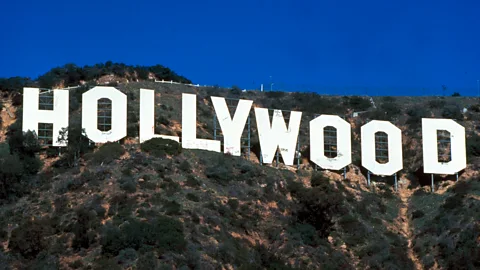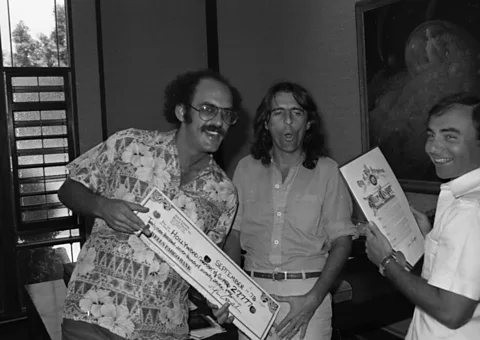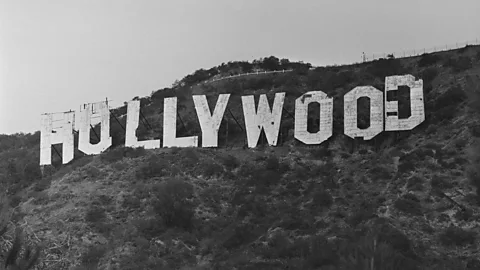Why Alice Cooper saved the Hollywood sign
 Getty Images
Getty ImagesFor more than 100 years, the sign has been a Los Angeles landmark both in real life and on the silver screen. In 1978, Alice Cooper told the BBC why he was helping to restore the dilapidated icon.
Perched high on Mount Lee overlooking Los Angeles, the Hollywood sign is one of America's most instantly recognisable cultural icons. "[It] is like our London Bridge, our Big Ben," US shock rocker Alice Cooper said on a BBC music show, The Old Grey Whistle Test, in 1978. "In Hollywood, we don't have a landmark except for the Hollywood sign."
The exact date the monument went up is contested, but its official centenary was celebrated on 13 July 2023, making it 102 years old this week. It has now become synonymous with the film industry, but it wasn't originally intended to be. In fact, it wasn't even meant to last longer than 18 months. The sign was designed as a short-lived billboard, advertising a new housing development in the Hollywood Hills. It consisted of 13 enormous capital letters, each 30ft (9m) wide and 45ft (14m) tall, that spelt out HOLLYWOODLAND – the name of the real estate group selling the properties. Made of wood and sheet metal and held up by a framework of telephone poles, the structure cost more than $23,000 (about $430,000 or £300,000 today) to build.
To ensure it was especially eye-catching, it was illuminated with almost 4,000 lights that would flash the different sections of the sign, HOLLY, WOOD and LAND, consecutively. A handyman, Albert Koeth, was hired to keep the sign in good order and replace the bulbs as they burnt out. The idea was to promote an aspirational lifestyle choice to LA citizens rather than to act as some sort of endorsement of the entertainment industry.
Over the following decade, as LA and the film business grew, the sign stayed in place. But as the depression of the 1930s began to bite, its upkeep was cut back, and it quickly fell into disrepair. The songwriter Eden Ahbez, an early proponent of living the hippie lifestyle, camped for a time underneath the first L of the sign. Ahbez would later find fame for writing the 1948 Nat King Cole hit single Nature Boy.
 Getty Images
Getty ImagesThe sign also began to achieve some unwelcome notoriety: its association with the death of aspiring Hollywood star Peg Entwistle linked it to the darker side of Tinseltown's allure. The 24-year-old Welsh-born actress had left a successful Broadway career to move to LA with dreams of becoming a film star. But after struggling to find success, on the night of 16 September 1932 Entwistle climbed a maintenance ladder to the top of the letter H and jumped to her death.
As the sign continued to rust and deteriorate, in 1944 the real estate company decided to donate it to the city, along with the remaining 425 acres of undeveloped land, for a token price of $1. By this time, a severe storm had already knocked down the letter H and many residents had come to regard the dilapidated sign as something of an eyesore. In 1949, a decision was reached to tear the whole thing down, but the Hollywood Chamber of Commerce managed to get the decision reversed on the proviso that they footed the bill to refurbish the crumbling sign and replace the missing letter. They shortened it, removing the LAND part, and a cultural icon was born.
But by the mid-1970s, through a combination of neglect, weather damage and vandalism, the now 50-year-old sign was falling apart again. By the time the BBC's Bob Harris came to interview Cooper in 1978, a severe storm had further disfigured it, breaking off part of the first O and sending a second O tumbling down the side of Mount Lee, leaving the sign to read HuLLYWO D.
The 'Save the Sign' campaign
"Nobody will take the responsibility for restoring it or anything," Cooper told the BBC. "The poor old thing is up there, dear to our hearts, and dying right in front of us. And I figured it would cost say $40,000 or $50,000 to restore. So I suggested that we would go and do a concert somewhere and just give them all the money," he said.
It would turn out that to bring the sign back to its former glory would cost considerably more than that. After compiling a structural report, the Hollywood Chamber of Commerce found that repairing the sign was impossible. It would need to be completely replaced. And to ensure it could withstand the winds on Mount Lee, the new steel letters would need to be supported by steel columns sunken into a concrete foundation. The price tag for this project would be $250,000.
In History
In History is a series which uses the BBC's unique audio and video archive to explore historical events that still resonate today. Sign up to the accompanying weekly newsletter.
A "Save the Sign" campaign was launched in May 1978, and the following month Hugh Hefner, founder of the international adult magazine Playboy, hosted a star-studded fundraiser at his mansion to raise money for the new sign. Cooper was the first person to sponsor a letter. "We figured it was $27,000 a piece, and I figured that would spark other people," he said.
The rocker paid for the final O, which he dedicated to his friend, the comedian and film star Groucho Marx, who had died the previous year. "And Andy Williams [the US singer known for his version of the song Moon River] donated a letter, and Warner Brothers of course did, and Gene Autry [famous as 'the Singing Cowboy'] and some really neat people did," said Cooper. "We more or less kicked it off, and I still believe that everybody in the world owes Hollywood a dollar at least for all the entertainment that comes out of Hollywood – and if we can't take care of it, the ones that live here, that's kind of silly."
 Getty Images
Getty ImagesThe old sign was demolished, and a new 450ft (137m) long sign weighing 240 tonnes erected in its place. It has become the symbol of the city and the seductive promise of the film business.
"When you look at the Hollywood sign, you think of Hollywood glamour. We know glamour isn't real, but it seems real," film researcher and journalist Karen Krizanovich told David Willis on the BBC's podcast H-O-L-L-Y-W-O-O-D in 2023. "When you see the Hollywood sign, you think it's real. This whole fantasy about Hollywood is real, because of that sign."
And the silver screen has responded in kind. Over the years, the Hollywood sign has featured in a myriad of films, starring alongside Charlton Heston in Earthquake (1974), Robert Downey Jr in Chaplin (1992) and Mila Kunis in Friends with Benefits (2011). But when it does turn up in films, such as Superman: The Movie (1978), The Day After Tomorrow (2004) and San Andreas (2015), it often doesn't make it out unscathed.
Over the years, it has been altered to reflect the times. In 1976, student Danny Finegood used curtains to make it read HOLLYWeeD to coincide with the relaxing of marijuana laws. The prank would happen again in 2017. When Pope John Paul II visited LA in 1987, it was altered to read HOLYWOOD. And the same year it was changed to OLLYWOOD in reference to Colonel Oliver North's testimony in the Iran-Contra scandal. On 31 December 1999 the new sign – which didn't have bulbs like the original – was lit up again for the first time in 60 years in a blaze of colours to celebrate the new millennium. During the closing ceremony of last year's Paris Olympics, its two Os were used to create the bottom two rings of the Olympic symbol in a nod to LA hosting the Games in 2028.
Speaking in 1978, Cooper, himself no stranger to theatricality, was comfortable with this dressing up of LA's most iconic monument. "I think they should have neon and flashing lights and everything on it," he said.
--
For more stories and never-before-published radio scripts to your inbox, sign up to the In History newsletter, while The Essential List delivers a handpicked selection of features and insights twice a week.
